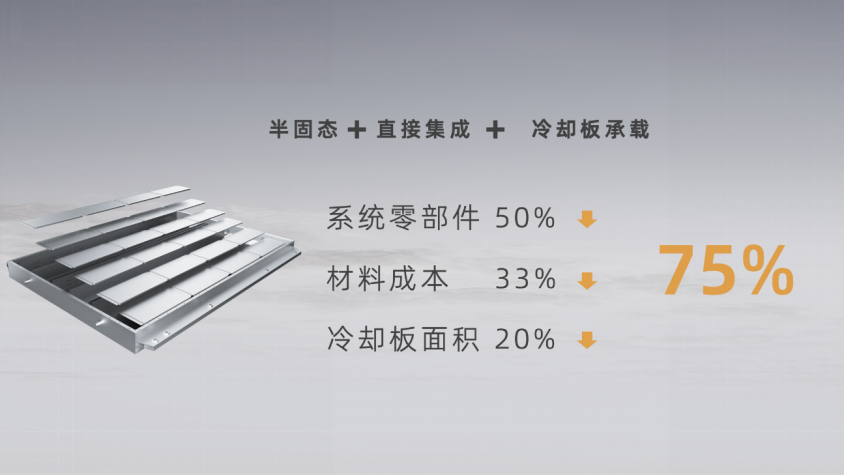Author: Lingfang Wang
Editor: Shiyun Zhu
FuNeng Technology, which has always been low-key, made a big move by adopting soft-pack batteries to produce battery packs with integrated capabilities that are not inferior to square batteries, and ultimately supporting vehicles with a range of 1000 kilometers or 5C ultra-fast charging.
FuNeng Technology calls it the “Super Pouch Solution” (SPS). On September 9th, at the “2022 FuNeng Technology Strategy and New Product Launch Conference” held in Beijing, FuNeng Technology officially launched this innovative solution that covers everything from battery cells to systems and from manufacturing to recycling.
What is impressive about SPS is that its integration, charging rate, safety, and standardization are all very high, and its cost is competitive.
This soft-pack battery-based solution has added variables to the competition in battery packaging technology. In addition to Ningde Times’ square route and Tesla’s 4680 cylindrical battery route, soft-pack batteries are also evolving.
In addition to the super pouch solution based on the ternary material, FuNeng Technology Chairman Wang Yu also showcased the development of other material systems in the production of battery cells for the first time at the conference.
-
FuNeng plans:
-
In 2023, launch the first-generation products of sodium-ion batteries, lithium iron phosphate, and lithium manganese phosphate.
-
By 2030, increase the energy density of sodium-ion batteries from 160 Wh/kg to 220 Wh/kg, and the energy density of lithium iron phosphate and lithium manganese phosphate will form a product coverage from 200 Wh/kg to 240 Wh/kg.
-
In 2024, launch low-nickel and manganese-rich systems products with an energy density of 250 Wh/kg.
-
By 2030, further increase the energy density of low-nickel and manganese-rich batteries to 290 Wh/kg.
-
By 2030, launch solid-state batteries with an energy density of 400-500 Wh/kg.
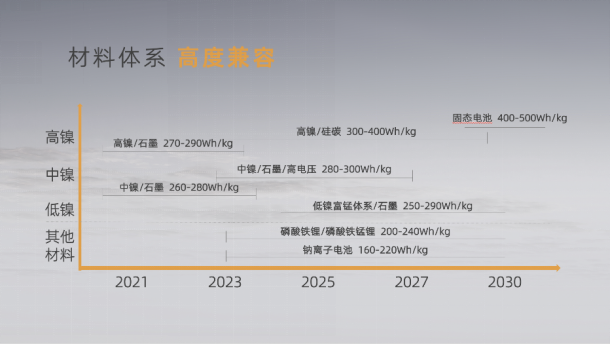
In terms of production capacity, FuNeng plans to expand its domestic and foreign production capacity to around 150 GWh by 2025.## Standard Battery Cell Compatible with All Models
The entire press conference revolved around the SPS super soft pack system solution newly developed by Funeng Technology.
As a systematically designed product, Funeng Technology’s SPS system can be adapted to all models of passenger cars with the same chassis and a single battery cell.
The specific approach is that Funeng Technology horizontally stacks soft pack battery cells and flexibly adjusts the height of the battery system by adjusting the height of the large soft pack battery cells arranged horizontally, so that the system height can be flexibly adjusted between 85mm and 145mm. It only needs to adjust the height of the liquid cooling plate to accommodate a power capacity of 80kWh to 150kWh, which meets the electrification needs of performance sports cars to urban pickups.
The benefits to the entire vehicle enterprise customers are shortened development cycles for new models, strong universality in key components such as battery cells and chassis, reduced procurement costs, and guarantee for stable supply.
The thickness of the soft pack battery cell is only 14-20mm, and the horizontal arrangement of the battery cell provides a lot of space for the chassis height and more flexible battery capacity.
In addition, Funeng Technology uses a bipolar ear design for the battery cell, which can provide higher rate performance and lower cell loss, making it more suitable for high-rate charging.
Of course, in addition to bipolar ear design, there are various directions for selecting ear design, such as up and down or sideways or even four sides, which can meet all types of vehicles including pure electric, plug-in hybrid, and hybrid.
Compared with square or cylindrical battery cell schemes, which can also be used as standard battery cells, their chassis height flexibility is insufficient.
Similar to CATL’s Kirin Battery, the Super Soft Pack system can also accommodate battery cells with different material systems, with unique features in battery thermal management.
Double-Sided Liquid Cooling and Three-Sided Heat Transfer
For high energy density battery packs, liquid cooling is already a must-have solution.
Funeng Technology’s liquid cooling solution adopts a vertical liquid cooling plate design. The blue part in the figure below should be the liquid cooling plate of the Super Soft Pack battery pack.
Both sides of the battery cell are liquid-cooled, and each battery cell is placed on an aluminum metal plate, which is folded and should be of the same thickness as the battery cell. The bottom and two-side aluminum plates serve as heat conductors and are connected to the two-side liquid cooling plates to take away the heat.
The liquid cooling plates on both sides of the battery cell can also serve as structural members to provide structural support, similar to the longitudinal beam structure of the battery pack.
Some industry insiders believe that the cooling efficiency of the cooling pipes on the battery surface, which also needs to be conducted through a thermal medium, may not be as good as the scheme that directly attaches the cooling pipes to the battery surface.
Wang Yu believes that for batteries, heat transfer is important, but heat accumulation is more important. It’s okay for the temperature to be a little high. What’s important is that the temperature of the battery core is uniform, which is conducive to extending the life of the battery.
Wang Yu stated that precise and comprehensive temperature control enables the battery system to cycle for more than 3,000 times.
Due to the improvement in thermal management, fast charging performance can also be improved. The data provided by Wang Yu shows that compared with its previous production of large module modes, the thermal management efficiency of the SPS battery system has improved by 4 times, and it has the capacity to discharge and charge at rates ranging from 2.4C to 5C or even higher.
In addition, on low-temperature performance, the full-polarity ear and stack technology of the large soft pack cells bring lower internal resistance and better low-temperature discharge performance to the cells. The addition of the liquid-cooled plate and nano-insulation materials balances the internal temperature of the battery system. In order to meet normal charging under extreme cold conditions, the SPS applies a brand-new low-temperature rapid self-heating design.
Experimental data shows that the SPS system capacity remains above 90% in an environment of minus 20 degrees Celsius, and the charging time is shortened by half.
“This means that after the 600-kilometer (long-range vehicle) is fully charged, it can run more than 500 kilometers in winter, which eliminates the anxiety over mileage in the future winter. ” Wang Yu said.
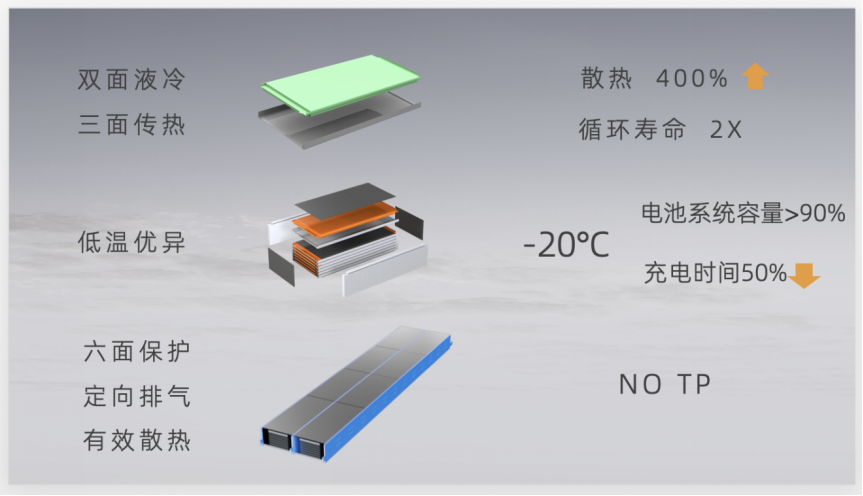
Another major highlight of the SPS battery is its management of thermal runaway.
Wang Yu stated that the SPS battery provides protection on all six sides: up, down, left, right, front, and back, and can achieve true NO TP (no thermal runaway propagation). Meanwhile, the liquid-cooled plate has a dedicated exhaust channel. When a battery is in a state of thermal runaway, high-temperature, high-pressure gas can be automatically discharged to avoid impacting the upper, lower, left, or right batteries.
Innovative high volume utilization rate of 75%
The SPS large soft pack battery system is also a CTP system without modules.
The SPS system employs an efficient liquid-cooled plate and chassis integrated design, and the semi-solid large soft pack battery cell is directly integrated into the system chassis. The liquid-cooled plate, cross and longitudinal beams are integrated, reducing the system components by 50%, lowering the material cost by 33%, and increasing the volume utilization rate by 30% to 75%.
This volume utilization rate is slightly higher than the 72% claimed by CATL’s KIRIN battery.
Thanks to the characteristics of stacked soft-pack cells, its volume utilization rate is naturally higher than that of square cells. However, due to the fact that aluminum sheets are placed between each layer of cells in the SPS system, the overall weight energy density performance of the battery pack may not be excellent.
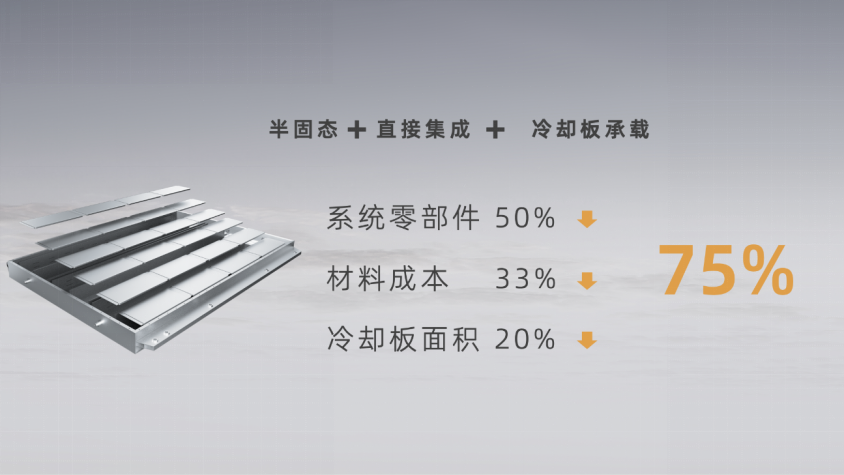
The volume utilization rate of the SPS system is certainly better than that of the 4680 system, with an increase of 12% compared to the 4680 system.
To this end, Wang Yu gave an example. Now, as long as all battery packs provided to customers adopt their latest SPS design, the capacity will increase by 30%. In other words, if a car model powered by ternary batteries has a range of 800 kilometers, the new system can achieve a range of 1000 kilometers; If a car model powered by lithium iron phosphate has a range of 500 kilometers, it can achieve a range of 600-700 kilometers.
5C or even higher charge and discharge rate
According to Wang Yu’s introduction, Funeng Technology’s SPS system has a charge and discharge rate of from 2.4C to 5C or even higher.
Wang Yu said that their design philosophy is 400 kilometers in 10 minutes. “We believe that 400 kilometers in 10 minutes can truly solve the customer’s anxiety about range and charging. So basically, after driving for 400 kilometers, most people need to take a break and have a cup of coffee, right? If 10 minutes can meet such charging requirements, then it is a relatively reasonable demand.”

The quick charging rate designed by Funeng Technology for vehicles with different range is different. For example, for a car with a range of 600 kilometers, they provide a 4C battery, which can be charged to 70% in 10 minutes and achieve a range of 400 kilometers; for a car model with a range of 800 kilometers, they use a 3C battery, which can be charged to 50% in 10 minutes, which is also 400 kilometers; for a car with a range of 1000 kilometers, they can provide a 2.4C solution, which can be charged to 40% in 10 minutes to meet the demand for 400 kilometers.
This is based on the layout plan of high-power charging piles in China. “Most of the layout of the country’s fast charging piles is at 300-350 kW, so to meet the charging requirements of a 4C 150-degree electric vehicle, a charging pile of 600 kW is required. (This design is) to meet customer needs, while being able to adapt to most charging piles, and to achieve the optimal solution with our battery design.”
Considerable reduction in manufacturing costs.Performance and cost are both important factors.
From a manufacturing perspective, the production of Funeon’s large soft-pack batteries will significantly reduce investments in manufacturing processes and costs. Equipment investment will decrease by 50%, factory floor space will decrease by 60%, and manufacturing energy consumption and costs will decrease by 35% and 30%, respectively. This greatly improves the investment output ratio of the large soft-pack batteries.
Specifically, equipment investment will be reduced by 50%, meaning that the previous investment of 100 million to 200 million yuan/GWh is now sufficient with just 100 million yuan, and factory floor space that previously required 20,000 square meters now only needs 10,000 square meters.
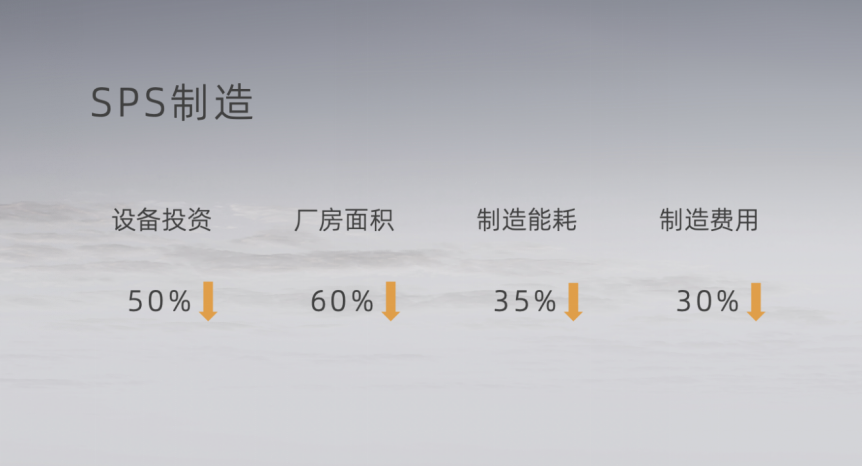
In addition, Funeon’s battery recycling technology also helps reduce carbon emissions and costs. According to Wang Yu, Funeon has spent more than 10 years developing and verifying direct recycling technology for lithium batteries, which can retain the crystal structure of positive electrode materials and use them again, further reducing costs and energy consumption, and increasing material utilization to more than 99%.
Based on data from third-party laboratories in the United States, batteries made with 25% of directly recycled positive electrode materials show no significant difference in performance compared to those made with brand new positive electrode materials.

Finally, in terms of production capacity planning, Wang Yu stated that Funeon plans to have 130GWh of production capacity in China, with locations confirmed in Ganzhou, Jiangxi, Zhenjiang, Jiangsu, and Wuhu, Anhui. Among them, Ganzhou plans to have 46GWh of production capacity, with 4GWh already in place and 12GWh in collaboration with Geely to be completed soon. Additionally, construction work for 30GWh of self-planned new production capacity has already begun.
Zhenjiang has a capacity of 24GWh, all of which has been completed and put into operation. Wuhu plans to build a capacity of 24GWh. In addition, Funeon plans to build 36GWh of production capacity in the southwest region to radiate the western market.

In terms of overseas plant construction, Funeon has already decided to build plants in Germany and Turkey in Europe, with a combined planned capacity of 16GWh, with construction already underway in Turkey.
Of course, the actual production capacity construction will be adjusted according to specific conditions, subject to official announcements from Funeon.It has to be said that this is a very content-rich press conference. The battery system design of Funeng Technology is also quite reasonable, achieving safety, performance, and cost effectiveness.
If Funeng Technology’s semi-solid state battery can land as scheduled, the SPS battery system launched this time is likely to become a product that car companies compete to adopt, helping Funeng Technology reverse the unfavorable situation of few and concentrated customers.
We also look forward to more battery companies contributing better product designs.
——END——
This article is a translation by ChatGPT of a Chinese report from 42HOW. If you have any questions about it, please email bd@42how.com.
